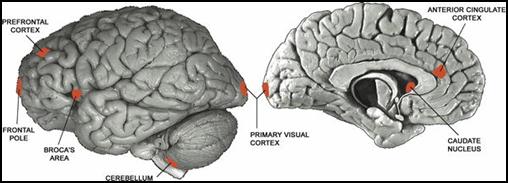|
|
Gene
Expression in the Aging Brain
Medical News
Today (from the PloS Biology Journal)
September
2, 2005

The Seven Regions of the Human Brain Analyzed in This Work
While medical science and a healthy lifestyle can help increase life expectancy, many aspects of aging and longevity are beyond our control. Published this week in the open-access journal PLoS Biology, Michael Eisen and colleagues shed light on these genetic factors by identifying sets of genes whose expression changes with age in human and chimp brains.
Using results from three microarray data studies performed in old and young humans and chimps in four different regions of the cortex (the brain region responsible for functions such as thinking), the authors found a pattern of age-related changes in the expression of hundreds of genes. Only one non-cortical region, the cerebellum (whose principal functions include movement), showed little change in age-related gene expression. Intriguingly, the set of affected cortical genes was different between humans and chimps. Since humans and chimps diverged about 5 million years ago - these changes have accumulated over a relatively short evolutionary time.
What might account for the difference? One common theory of aging holds that damage is done to DNA and proteins by "free-radicals" (highly reactive molecules produced by the metabolic activity of mitochondria). It predicts that more metabolically active tissues will show greater age-related differential gene expression. The results of this study support this theory since the more metabolically active cortex shows a greater reduction in gene activity.
These results raise questions about age-related gene expression changes, including whether metabolically active non-brain tissues display similar patterns, and whether the divergence between human and chimp patterns was the direct result of selection or an inevitable consequence of some other difference in brain evolution. The patterns seen here provide a starting point for understanding genetic changes in aging, and may reveal targets for treatment of neurodegenerative diseases.
|
|



